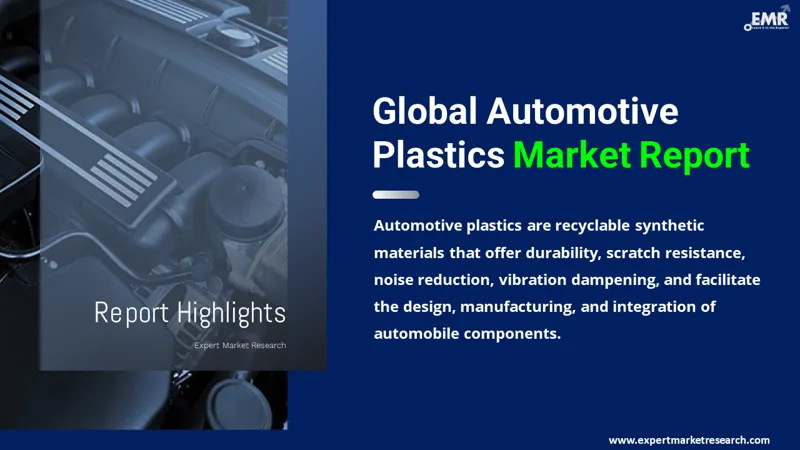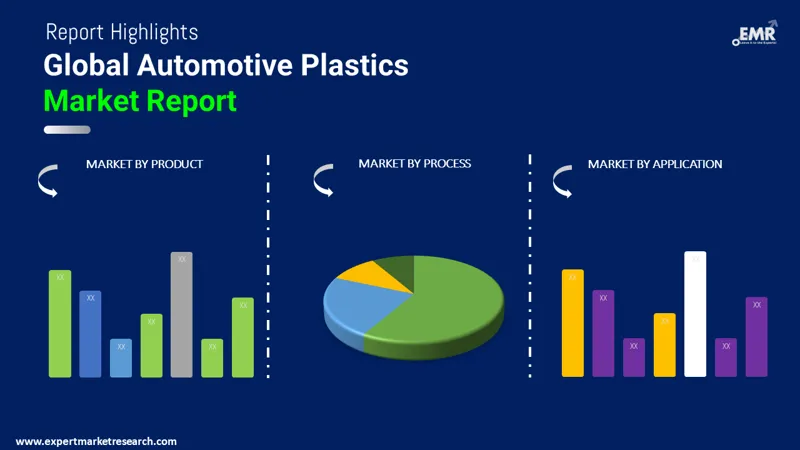
Consumer Insights
Uncover trends and behaviors shaping consumer choices today
Procurement Insights
Optimize your sourcing strategy with key market data
Industry Stats
Stay ahead with the latest trends and market analysis.
The global automotive plastics market reached a value of about USD 26.44 Billion in 2025. The industry is further expected to grow at a CAGR of about 8.00% in the forecast period of 2026-2035 to reach a value of around USD 57.08 Billion by 2035.
Base Year
Historical Period
Forecast Period
Compound Annual Growth Rate
8%
Value in USD Billion
2026-2035
*this image is indicative*
The Asia Pacific accounts for one of the largest shares of the automotive plastics market for passenger cars. The region is the hub for foreign investments and booming industrial sectors, mainly because of the low-cost labour, easy availability of raw materials, increased adoption of modern technologies, innovations, and easy availability of inexpensive lands. India, China, South Korea, and Japan are the major countries in the region.

Read more about this report - REQUEST FREE SAMPLE COPY IN PDF
China is the largest automotive plastics market for passenger cars in the Asia Pacific, owing to the presence of major automobile companies. India is one of the leading passenger vehicles manufacturing hubs, making it a lucrative market for automotive plastics. Despite pandemic and supply chain issues, total passenger vehicle sales in India climbed by 11.4% in January 2020, according to the Society of Indian Automobile Manufacturers (SIAM). Growing middle-class population, industrialisation, rising disposable income, and changing lifestyles are expected to drive the demand for passenger vehicles, providing various growth prospects to the automotive plastics market for passenger cars in China. Strong government support and increased government investment are also moving the region's automotive industry forward, which is expected to stimulate demand for the product in the region.
During the anticipated period, the automotive plastics market in North America is expected to rise significantly. The region’s stringent regulatory scenario targets a decline in automotive emission, spurring the adoption of high-performance plastics over conventional metals to reduce vehicle weight. The increasing iron and steel prices are also expected to foster the demand for plastics in automobiles. The growing demand for electric vehicles in North America is expected to promote growth opportunities to the region.
Due to the COVID-19 outbreak, the automotive industry has been one of the hardest hit industries, as movement restrictions and work from home routines decreased demand for new vehicles and aftermarket spares. However, the automotive sector is expected to post a healthy recovery in 2021, although reaching pre-pandemic status would still take some time. Nonetheless, this will enable higher opportunities for automotive plastic sales compared to those registered in the last five years.

Read more about this report - REQUEST FREE SAMPLE COPY IN PDF
Automotive plastics refers to the type of synthetic material that is recyclable, sturdy, scratch-resistant, abrasion-resistant, reduces vibration and noise, and enables the design, manufacturing, and integration of components in automobiles. Dashboards, fuel systems, bumpers, seats, liquid reservoirs, body panels, under-bonnet parts, interior trim, electrical components, exterior trim, lighting, and upholstery are examples of automotive plastics employed.
Market Breakup by Product
Market Breakup by Process
Market Breakup by Application
Market Breakup by Region
Several governments have enacted strict automobile pollution and fuel economy rules. These laws have driven automakers to employ more lightweight materials, such as plastics, in their vehicles. Advanced plastics materials improve a vehicle's fuel economy while also ensuring safety and performance, propelling the global automotive plastics industry forward. Major factors driving the growth of the automotive plastics market include maximum bulk reduction possibilities and improved vehicle design and aesthetics. The growing use of plastics in powertrain engineering is likely to drive market expansion. Over the forecast period, rising product demand from the automobile industry for usage in refrigeration insulation, interior trimmings, and seat cushioning is predicted to enhance demand. Rising demand for fuel efficiency, greater comfort, and sustainable materials for automotive components are key factors driving the adoption of automotive plastics in the conventional cars segment. The rapid adoption of electric road vehicles and the application of polymers in automobiles are transforming the global automotive sector. The electrification of the vehicle fleet has been accelerating the demand for polymers for the last few years, with impetus from regulatory incentives, the development of inexpensive electric vehicles, and changing consumer perceptions.
The report gives a detailed analysis of the following key players in the global automotive plastics market, covering their competitive landscape, capacity, and latest developments like mergers, acquisitions, and investments, expansions of capacity, and plant turnarounds:
The comprehensive EMR report provides an in-depth assessment of the market based on the Porter's five forces model along with giving a SWOT analysis.




*While we strive to always give you current and accurate information, the numbers depicted on the website are indicative and may differ from the actual numbers in the main report. At Expert Market Research, we aim to bring you the latest insights and trends in the market. Using our analyses and forecasts, stakeholders can understand the market dynamics, navigate challenges, and capitalize on opportunities to make data-driven strategic decisions.*
Get in touch with us for a customized solution tailored to your unique requirements and save upto 35%!
In 2025, the global automotive plastics market attained a value of nearly USD 26.44 Billion.
The market is projected to grow at a CAGR of 8.00% between 2026 and 2035.
The market is estimated to witness a healthy growth in the forecast period of 2026-2035 to reach USD 57.08 Billion by 2035.
The major drivers of the market include the industrialisation, maximum bulk reduction possibilities and improved vehicle design, growing use of plastics in powertrain engineering, greater comfort, and sustainable materials, rapid adoption of electric road vehicles and the application of polymers in automobiles, and changing consumer perceptions.
Adoption of lightweight materials due to stringent emission and fuel economy regulations and government initiatives are the key industry trends propelling the growth of the market.
The major regions in the industry are North America, Latin America, the Middle East and Africa, Europe, and the Asia Pacific.
The major products in the industry include Acrylonitrile Butadiene Styrene (ABS), Polypropylene (PP), Polyurethane (PU), Polyvinyl Chloride (PVC), Polyethylene (PE), Polycarbonate (PC), Polymethyl Methacrylate (PMMA), and Polyamide (PA), among others.
The process in the industry includes injection moulding, blow moulding, and thermoforming, among others.
The product finds wide applications in powertrain, electrical components, interior furnishings, exterior furnishings, and under-the-hood components, among chassis.
The major players in the industry are BASF SE, Covestro AG, SABIC, Dow Inc., and Borealis AG, among others.
Explore our key highlights of the report and gain a concise overview of key findings, trends, and actionable insights that will empower your strategic decisions.
| REPORT FEATURES | DETAILS |
| Base Year | 2025 |
| Historical Period | 2019-2025 |
| Forecast Period | 2026-2035 |
| Scope of the Report |
Historical and Forecast Trends, Industry Drivers and Constraints, Historical and Forecast Market Analysis by Segment:
|
| Breakup by Product |
|
| Breakup by Process |
|
| Breakup by Application |
|
| Breakup by Region |
|
| Market Dynamics |
|
| Competitive Landscape |
|
| Companies Covered |
|
| Report Price and Purchase Option | Explore our purchase options that are best suited to your resources and industry needs. |
| Delivery Format | Delivered as an attached PDF and Excel through email, with an option of receiving an editable PPT, according to the purchase option. |
Single User License
One User
USD 3,999
USD 3,599
tax inclusive*
Datasheet
One User
USD 2,499
USD 2,249
tax inclusive*
Five User License
Five User
USD 4,999
USD 4,249
tax inclusive*
Corporate License
Unlimited Users
USD 5,999
USD 5,099
tax inclusive*
*Please note that the prices mentioned below are starting prices for each bundle type. Kindly contact our team for further details.*
Flash Bundle
Small Business Bundle
Growth Bundle
Enterprise Bundle
*Please note that the prices mentioned below are starting prices for each bundle type. Kindly contact our team for further details.*
Flash Bundle
Number of Reports: 3
20%
tax inclusive*
Small Business Bundle
Number of Reports: 5
25%
tax inclusive*
Growth Bundle
Number of Reports: 8
30%
tax inclusive*
Enterprise Bundle
Number of Reports: 10
35%
tax inclusive*
How To Order

Select License Type
Choose the right license for your needs and access rights.

Click on ‘Buy Now’
Add the report to your cart with one click and proceed to register.

Select Mode of Payment
Choose a payment option for a secure checkout. You will be redirected accordingly.
Gain insights to stay ahead and seize opportunities.

Get insights & trends for a competitive edge.

Track prices with detailed trend reports.

Analyse trade data for supply chain insights.

Leverage cost reports for smart savings

Enhance supply chain with partnerships.

Connect For More Information
Our expert team of analysts will offer full support and resolve any queries regarding the report, before and after the purchase.
Our expert team of analysts will offer full support and resolve any queries regarding the report, before and after the purchase.
We employ meticulous research methods, blending advanced analytics and expert insights to deliver accurate, actionable industry intelligence, staying ahead of competitors.
Our skilled analysts offer unparalleled competitive advantage with detailed insights on current and emerging markets, ensuring your strategic edge.
We offer an in-depth yet simplified presentation of industry insights and analysis to meet your specific requirements effectively.
Share